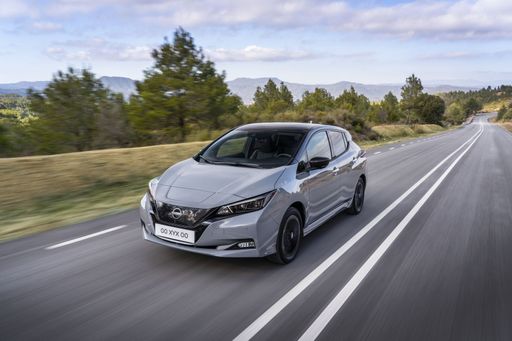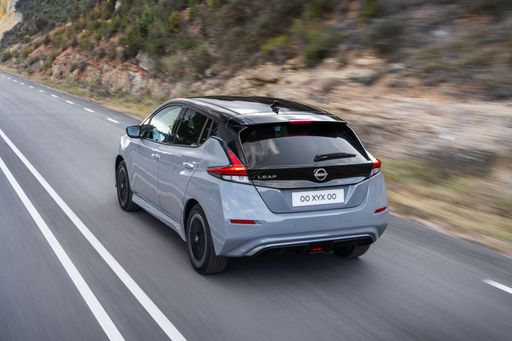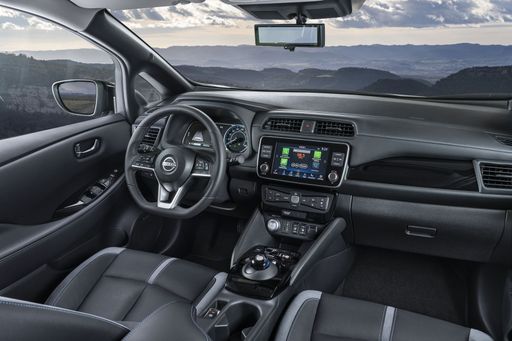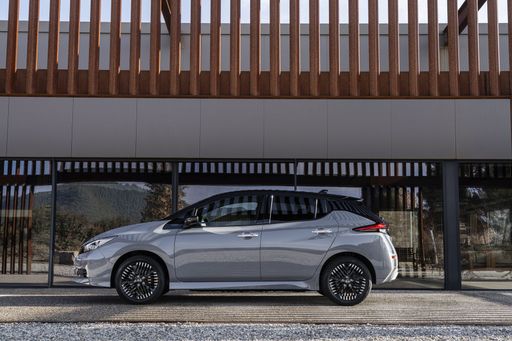Nissan Leaf VS Volvo ES90 – Specs, Efficiency & Price Comparison
Which model is the better choice – the Nissan Leaf or the Volvo ES90? We compare performance (217 HP vs 680 HP), boot capacity (394 L vs 424 L), efficiency (16.70 kWh vs 16.10 kWh), and of course, the price (30800 £ vs 61700 £).
Find out now which car fits your needs better!
The Nissan Leaf (Hatchback) is powered by a Electric engine and comes with a Automatic transmission. In comparison, the Volvo ES90 (Hatchback) features a Electric engine and a Automatic gearbox.
When it comes to boot capacity, the Nissan Leaf offers 394 L, while the Volvo ES90 provides 424 L – depending on what matters most to you. If you’re looking for more power, you’ll need to decide whether the 217 HP of the Nissan Leaf or the 680 HP of the Volvo ES90 suits your needs better.
There are also differences in efficiency: 16.70 kWh vs 16.10 kWh. In terms of price, the Nissan Leaf starts at 30800 £, while the Volvo ES90 is available from 61700 £.
Compare all the key specs now and find out which model fits your lifestyle best!
Nissan Leaf
The Nissan Leaf stands out as a pioneering model in the realm of electric vehicles, known for its impressive blend of practicality and eco-friendliness. It offers a smooth and quiet driving experience, making it an ideal choice for city commuting and longer journeys alike. The interior design is both comfortable and intuitive, providing drivers with a sense of modernity and ease of use.
details @ germany.nissannews.com
@ germany.nissannews.com
 @ germany.nissannews.com
@ germany.nissannews.com
 @ germany.nissannews.com
@ germany.nissannews.com
 @ germany.nissannews.com
@ germany.nissannews.com
Volvo ES90
The Volvo ES90 stands out as a luxury sedan, embodying Scandinavian elegance combined with innovative technology. Its sleek design is complemented by a plush interior that emphasizes comfort and safety, aligning with Volvo's renowned reputation. With advanced features and a focus on sustainability, the ES90 is a testament to the brand's commitment to responsible luxury.
details

|
|
|
|
|
Costs and Consumption |
|
|---|---|
|
Price
30800 - 37200 £
|
Price
61700 - 81000 £
|
|
Consumption L/100km
-
|
Consumption L/100km
-
|
|
Consumption kWh/100km
16.7 - 17.8 kWh
|
Consumption kWh/100km
16.1 - 17.1 kWh
|
|
Electric Range
270 - 385 km
|
Electric Range
650 - 700 km
|
|
Battery Capacity
39 - 59 kWh
|
Battery Capacity
88 - 102 kWh
|
|
co2
0 g/km
|
co2
0 g/km
|
|
Fuel tank capacity
-
|
Fuel tank capacity
-
|
Dimensions and Body |
|
|---|---|
|
Body Type
Hatchback
|
Body Type
Hatchback
|
|
Seats
5
|
Seats
5
|
|
Doors
5
|
Doors
5
|
|
Curb weight
1580 - 1756 kg
|
Curb weight
2441 - 2628 kg
|
|
Trunk capacity
385 - 394 L
|
Trunk capacity
424 L
|
|
Length
4490 mm
|
Length
5000 mm
|
|
Width
1788 mm
|
Width
1942 mm
|
|
Height
1540 - 1545 mm
|
Height
1546 mm
|
|
Payload
384 - 415 kg
|
Payload
409 - 412 kg
|
Engine and Performance |
|
|---|---|
|
Engine Type
Electric
|
Engine Type
Electric
|
|
Transmission
Automatic
|
Transmission
Automatic
|
|
Transmission Detail
Reduction Gearbox
|
Transmission Detail
-
|
|
Drive Type
Front-Wheel Drive
|
Drive Type
Rear-Wheel Drive, All-Wheel Drive
|
|
Power HP
150 - 217 HP
|
Power HP
333 - 680 HP
|
|
Acceleration 0-100km/h
6.9 - 7.9 s
|
Acceleration 0-100km/h
4 - 6.9 s
|
|
Max Speed
144 - 157 km/h
|
Max Speed
180 km/h
|
|
Torque
320 - 340 Nm
|
Torque
480 - 870 Nm
|
|
Number of Cylinders
-
|
Number of Cylinders
-
|
|
Power kW
110 - 160 kW
|
Power kW
245 - 500 kW
|
|
Engine capacity
-
|
Engine capacity
-
|
General |
|
|---|---|
|
Model Year
2019
|
Model Year
2025
|
|
CO2 Efficiency Class
A
|
CO2 Efficiency Class
A
|
|
Brand
Nissan
|
Brand
Volvo
|
Nissan Leaf
Introduction to the Nissan Leaf: A Pioneer in Electric Mobility
The Nissan Leaf has established itself as a trailblazer in the realm of electric vehicles (EVs) since its launch. As we delve into its present-day iterations, the Leaf continues to soar in popularity due to remarkable advancements in technology and sustainability. Let's explore what makes the Nissan Leaf a standout in today's automotive market.
Power and Performance: Under the Hood of the Nissan Leaf
The Nissan Leaf boasts a power output ranging from 150 to 217 PS, depending on the battery option chosen. The vehicle's electric motor, a product of cutting-edge engineering, offers instant torque ranging from 320 to 340 Nm, resulting in impressive acceleration capabilities. The 0 to 100 km/h dash is achieved in as little as 6.9 seconds, showcasing its prowess in electric performance.
Battery Technology: Efficient Energy Management
When discussing the Nissan Leaf, battery technology is at the forefront. The available battery capacities range from 39 to 59 kWh, supporting an electric range between 270 to 385 km. This flexibility allows drivers to choose a model that best fits their driving habits, providing peace of mind for longer journeys without frequent recharging.
Sustainability: The Environmental Edge
One of the primary attractions of the Nissan Leaf is its commitment to sustainability. As an all-electric vehicle, it produces zero CO2 emissions, placing it in the top tier of the CO2-efficiency class with an 'A' rating. This clean energy approach contributes significantly to reducing environmental impact and supports Nissan's drive towards a greener future.
Design and Comfort: Aesthetic Appeal and Practicality
The Nissan Leaf is not just about efficiency; it's also designed for comfort and utility. With its sleek hatchback body and dimensions of 4490 mm in length, 1788 mm in width, and a height of up to 1545 mm, it offers ample interior space. The boot capacity ranges from 385 to 394 litres, providing sufficient storage for everyday needs. The model accommodates five passengers comfortably, ensuring a pleasant ride for everyone.
Innovations and Safety: Advanced Features for Peace of Mind
Nissan equips the Leaf with an array of intelligent features that enhance safety and convenience. The available equipment lines, including N-CONNECTA, Tekna, e+ N-CONNECTA, and e+ Tekna, offer varying levels of technology integration. ProPILOT Assist, e-Pedal, and a comprehensive suite of driver-assistance technology are just a few examples that highlight Nissan's commitment to innovation in the EV market.
Conclusion: The Nissan Leaf Continues to Lead
With prices ranging from €35,900 to €43,400, the Nissan Leaf remains an attractive choice for those looking to embrace electric mobility. It perfectly balances performance, design, and sustainability, making it a compelling choice in the competitive EV landscape. The Nissan Leaf not only represents the future of driving but also reinforces why it continues to be a leader in the electric vehicle community.
Volvo ES90
Introducing the Revolutionary Volvo ES90
The Volvo ES90 is setting remarkable standards in the realm of electric vehicles. This innovative hatchback blends cutting-edge technology with sleek Scandinavian design, offering two variants tailored for varying driving preferences. Available in both Single Motor Rear-Wheel Drive and Twin Motor All-Wheel Drive configurations, the ES90 meets the needs of eco-conscious drivers demanding performance and efficiency.
Powerful Performance Meets Unmatched Efficiency
Equipped with an all-electric powertrain, the Volvo ES90 delivers 333 to an astonishing 680 horsepower, depending on the chosen model. The advanced battery systems boast capacities ranging from 88 to 102 kWh, ensuring impressive ranges between 650 to 700 kilometers on a single charge. The acceleration is equally remarkable, with the quickest model reaching 0-100 km/h in a mere 4 seconds.
State-of-the-Art Design and Dimensions
Volvo's signature attention to detail is embodied in the ES90's design. With a sleek length of 5000 mm, a width of 1942 mm, and a height of 1546 mm, it maintains an elegant yet dynamic stance. Internally, the Hatchback configuration includes five doors, comfortably accommodating up to five passengers without compromising on trunk capacity, which stands at 424 liters.
Innovative Electric Technology
The Volvo ES90's engineering marvels extend beyond its powerboat. Its electric drivetrain delivers a seamless experience with automatic transmission, a maximum speed of 180 km/h, and torque ranging from 480 to 870 Nm. Its dual motor variant also sports an all-wheel-drive capability that assures superior traction and control, even in challenging conditions.
Pioneering Sustainability and Safety
Volvo's commitment to sustainability is reaffirmed with the ES90's zero-emission capability, classifying it in CO2 Efficiency Class A. Safety, a hallmark of the Volvo brand, comes reinforced with advanced driver-assistance systems, ensuring the highest standards for both occupants and pedestrians.
Comfortable and Tech-Forward Interiors
Inside, the Volvo ES90 embraces its Scandinavian roots with minimalist design, featuring premium materials and state-of-the-art technology. The intuitive infotainment system and connectivity options ensure a modern driving experience, while the spacious and ergonomic seating arrangement highlights Volvo's focus on passenger comfort.
The Future of Electric Driving
Produced for the 2025 model year, the Volvo ES90 stands as a testament to the brand's dedication to innovation in the electric vehicle domain. Perfectly combining performance, sustainability, and luxury, the ES90 is poised to redefine driving in the electrified era, cementing its place in the future of automotive excellence.
The prices and data displayed are estimates based on German list prices and may vary by country. This information is not legally binding.
